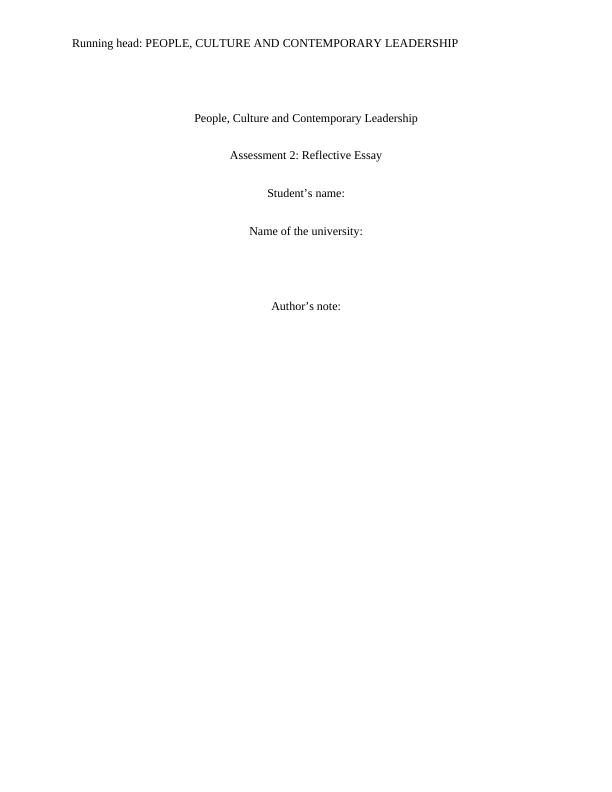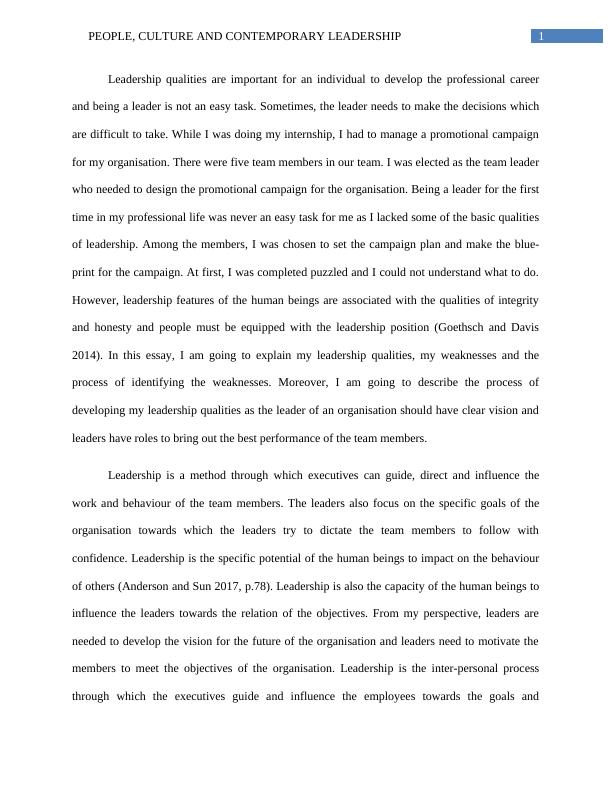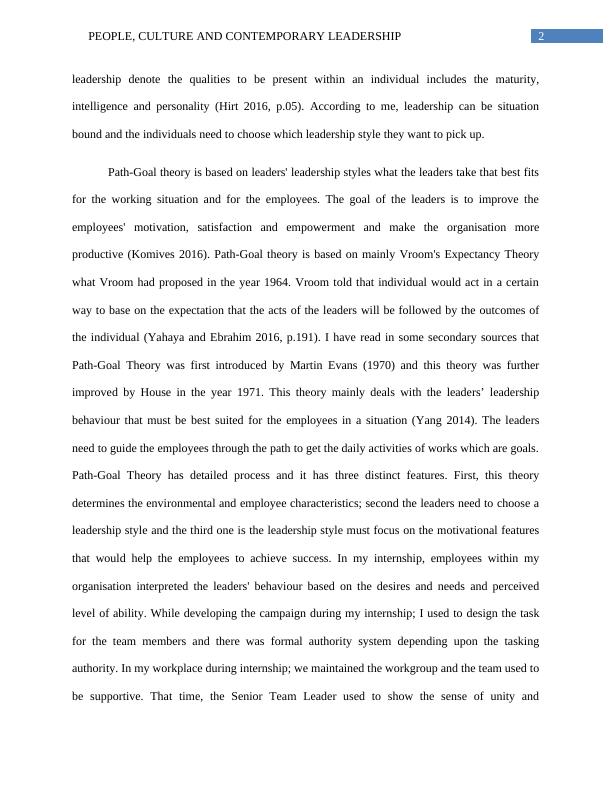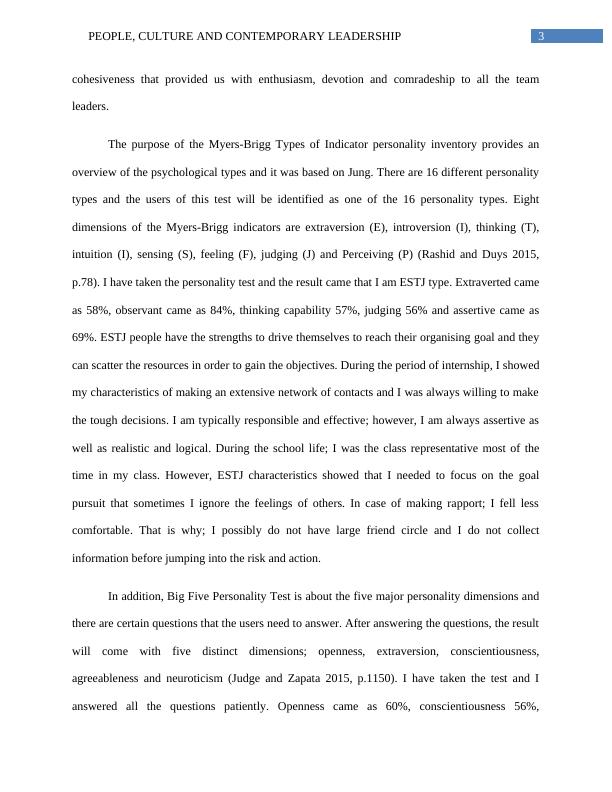People, Culture and Contemporary Leadership - Reflective Essay
Added on 2023-06-12
16 Pages3119 Words474 Views
Running head: PEOPLE, CULTURE AND CONTEMPORARY LEADERSHIP
People, Culture and Contemporary Leadership
Assessment 2: Reflective Essay
Student’s name:
Name of the university:
Author’s note:
People, Culture and Contemporary Leadership
Assessment 2: Reflective Essay
Student’s name:
Name of the university:
Author’s note:

1PEOPLE, CULTURE AND CONTEMPORARY LEADERSHIP
Leadership qualities are important for an individual to develop the professional career
and being a leader is not an easy task. Sometimes, the leader needs to make the decisions which
are difficult to take. While I was doing my internship, I had to manage a promotional campaign
for my organisation. There were five team members in our team. I was elected as the team leader
who needed to design the promotional campaign for the organisation. Being a leader for the first
time in my professional life was never an easy task for me as I lacked some of the basic qualities
of leadership. Among the members, I was chosen to set the campaign plan and make the blue-
print for the campaign. At first, I was completed puzzled and I could not understand what to do.
However, leadership features of the human beings are associated with the qualities of integrity
and honesty and people must be equipped with the leadership position (Goethsch and Davis
2014). In this essay, I am going to explain my leadership qualities, my weaknesses and the
process of identifying the weaknesses. Moreover, I am going to describe the process of
developing my leadership qualities as the leader of an organisation should have clear vision and
leaders have roles to bring out the best performance of the team members.
Leadership is a method through which executives can guide, direct and influence the
work and behaviour of the team members. The leaders also focus on the specific goals of the
organisation towards which the leaders try to dictate the team members to follow with
confidence. Leadership is the specific potential of the human beings to impact on the behaviour
of others (Anderson and Sun 2017, p.78). Leadership is also the capacity of the human beings to
influence the leaders towards the relation of the objectives. From my perspective, leaders are
needed to develop the vision for the future of the organisation and leaders need to motivate the
members to meet the objectives of the organisation. Leadership is the inter-personal process
through which the executives guide and influence the employees towards the goals and
Leadership qualities are important for an individual to develop the professional career
and being a leader is not an easy task. Sometimes, the leader needs to make the decisions which
are difficult to take. While I was doing my internship, I had to manage a promotional campaign
for my organisation. There were five team members in our team. I was elected as the team leader
who needed to design the promotional campaign for the organisation. Being a leader for the first
time in my professional life was never an easy task for me as I lacked some of the basic qualities
of leadership. Among the members, I was chosen to set the campaign plan and make the blue-
print for the campaign. At first, I was completed puzzled and I could not understand what to do.
However, leadership features of the human beings are associated with the qualities of integrity
and honesty and people must be equipped with the leadership position (Goethsch and Davis
2014). In this essay, I am going to explain my leadership qualities, my weaknesses and the
process of identifying the weaknesses. Moreover, I am going to describe the process of
developing my leadership qualities as the leader of an organisation should have clear vision and
leaders have roles to bring out the best performance of the team members.
Leadership is a method through which executives can guide, direct and influence the
work and behaviour of the team members. The leaders also focus on the specific goals of the
organisation towards which the leaders try to dictate the team members to follow with
confidence. Leadership is the specific potential of the human beings to impact on the behaviour
of others (Anderson and Sun 2017, p.78). Leadership is also the capacity of the human beings to
influence the leaders towards the relation of the objectives. From my perspective, leaders are
needed to develop the vision for the future of the organisation and leaders need to motivate the
members to meet the objectives of the organisation. Leadership is the inter-personal process
through which the executives guide and influence the employees towards the goals and

2PEOPLE, CULTURE AND CONTEMPORARY LEADERSHIP
leadership denote the qualities to be present within an individual includes the maturity,
intelligence and personality (Hirt 2016, p.05). According to me, leadership can be situation
bound and the individuals need to choose which leadership style they want to pick up.
Path-Goal theory is based on leaders' leadership styles what the leaders take that best fits
for the working situation and for the employees. The goal of the leaders is to improve the
employees' motivation, satisfaction and empowerment and make the organisation more
productive (Komives 2016). Path-Goal theory is based on mainly Vroom's Expectancy Theory
what Vroom had proposed in the year 1964. Vroom told that individual would act in a certain
way to base on the expectation that the acts of the leaders will be followed by the outcomes of
the individual (Yahaya and Ebrahim 2016, p.191). I have read in some secondary sources that
Path-Goal Theory was first introduced by Martin Evans (1970) and this theory was further
improved by House in the year 1971. This theory mainly deals with the leaders’ leadership
behaviour that must be best suited for the employees in a situation (Yang 2014). The leaders
need to guide the employees through the path to get the daily activities of works which are goals.
Path-Goal Theory has detailed process and it has three distinct features. First, this theory
determines the environmental and employee characteristics; second the leaders need to choose a
leadership style and the third one is the leadership style must focus on the motivational features
that would help the employees to achieve success. In my internship, employees within my
organisation interpreted the leaders' behaviour based on the desires and needs and perceived
level of ability. While developing the campaign during my internship; I used to design the task
for the team members and there was formal authority system depending upon the tasking
authority. In my workplace during internship; we maintained the workgroup and the team used to
be supportive. That time, the Senior Team Leader used to show the sense of unity and
leadership denote the qualities to be present within an individual includes the maturity,
intelligence and personality (Hirt 2016, p.05). According to me, leadership can be situation
bound and the individuals need to choose which leadership style they want to pick up.
Path-Goal theory is based on leaders' leadership styles what the leaders take that best fits
for the working situation and for the employees. The goal of the leaders is to improve the
employees' motivation, satisfaction and empowerment and make the organisation more
productive (Komives 2016). Path-Goal theory is based on mainly Vroom's Expectancy Theory
what Vroom had proposed in the year 1964. Vroom told that individual would act in a certain
way to base on the expectation that the acts of the leaders will be followed by the outcomes of
the individual (Yahaya and Ebrahim 2016, p.191). I have read in some secondary sources that
Path-Goal Theory was first introduced by Martin Evans (1970) and this theory was further
improved by House in the year 1971. This theory mainly deals with the leaders’ leadership
behaviour that must be best suited for the employees in a situation (Yang 2014). The leaders
need to guide the employees through the path to get the daily activities of works which are goals.
Path-Goal Theory has detailed process and it has three distinct features. First, this theory
determines the environmental and employee characteristics; second the leaders need to choose a
leadership style and the third one is the leadership style must focus on the motivational features
that would help the employees to achieve success. In my internship, employees within my
organisation interpreted the leaders' behaviour based on the desires and needs and perceived
level of ability. While developing the campaign during my internship; I used to design the task
for the team members and there was formal authority system depending upon the tasking
authority. In my workplace during internship; we maintained the workgroup and the team used to
be supportive. That time, the Senior Team Leader used to show the sense of unity and

3PEOPLE, CULTURE AND CONTEMPORARY LEADERSHIP
cohesiveness that provided us with enthusiasm, devotion and comradeship to all the team
leaders.
The purpose of the Myers-Brigg Types of Indicator personality inventory provides an
overview of the psychological types and it was based on Jung. There are 16 different personality
types and the users of this test will be identified as one of the 16 personality types. Eight
dimensions of the Myers-Brigg indicators are extraversion (E), introversion (I), thinking (T),
intuition (I), sensing (S), feeling (F), judging (J) and Perceiving (P) (Rashid and Duys 2015,
p.78). I have taken the personality test and the result came that I am ESTJ type. Extraverted came
as 58%, observant came as 84%, thinking capability 57%, judging 56% and assertive came as
69%. ESTJ people have the strengths to drive themselves to reach their organising goal and they
can scatter the resources in order to gain the objectives. During the period of internship, I showed
my characteristics of making an extensive network of contacts and I was always willing to make
the tough decisions. I am typically responsible and effective; however, I am always assertive as
well as realistic and logical. During the school life; I was the class representative most of the
time in my class. However, ESTJ characteristics showed that I needed to focus on the goal
pursuit that sometimes I ignore the feelings of others. In case of making rapport; I fell less
comfortable. That is why; I possibly do not have large friend circle and I do not collect
information before jumping into the risk and action.
In addition, Big Five Personality Test is about the five major personality dimensions and
there are certain questions that the users need to answer. After answering the questions, the result
will come with five distinct dimensions; openness, extraversion, conscientiousness,
agreeableness and neuroticism (Judge and Zapata 2015, p.1150). I have taken the test and I
answered all the questions patiently. Openness came as 60%, conscientiousness 56%,
cohesiveness that provided us with enthusiasm, devotion and comradeship to all the team
leaders.
The purpose of the Myers-Brigg Types of Indicator personality inventory provides an
overview of the psychological types and it was based on Jung. There are 16 different personality
types and the users of this test will be identified as one of the 16 personality types. Eight
dimensions of the Myers-Brigg indicators are extraversion (E), introversion (I), thinking (T),
intuition (I), sensing (S), feeling (F), judging (J) and Perceiving (P) (Rashid and Duys 2015,
p.78). I have taken the personality test and the result came that I am ESTJ type. Extraverted came
as 58%, observant came as 84%, thinking capability 57%, judging 56% and assertive came as
69%. ESTJ people have the strengths to drive themselves to reach their organising goal and they
can scatter the resources in order to gain the objectives. During the period of internship, I showed
my characteristics of making an extensive network of contacts and I was always willing to make
the tough decisions. I am typically responsible and effective; however, I am always assertive as
well as realistic and logical. During the school life; I was the class representative most of the
time in my class. However, ESTJ characteristics showed that I needed to focus on the goal
pursuit that sometimes I ignore the feelings of others. In case of making rapport; I fell less
comfortable. That is why; I possibly do not have large friend circle and I do not collect
information before jumping into the risk and action.
In addition, Big Five Personality Test is about the five major personality dimensions and
there are certain questions that the users need to answer. After answering the questions, the result
will come with five distinct dimensions; openness, extraversion, conscientiousness,
agreeableness and neuroticism (Judge and Zapata 2015, p.1150). I have taken the test and I
answered all the questions patiently. Openness came as 60%, conscientiousness 56%,

End of preview
Want to access all the pages? Upload your documents or become a member.
Related Documents
Leadership and Talent Management: A Reflective Journallg...
|8
|2523
|95
Leadership: Reflection, Recommendations, and Theorieslg...
|8
|1945
|4
Leadership Development Plan for Deskliblg...
|10
|3540
|309
People Culture and Contemporary Leadershiplg...
|8
|2542
|28
People Culture and Contemporary leadership Assignmentlg...
|15
|2971
|40
Leadership and Management: Theory and Practicelg...
|11
|2575
|404